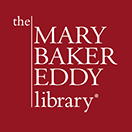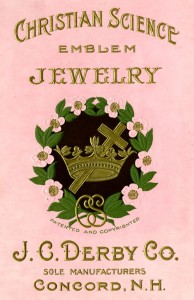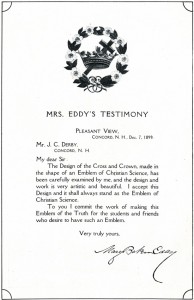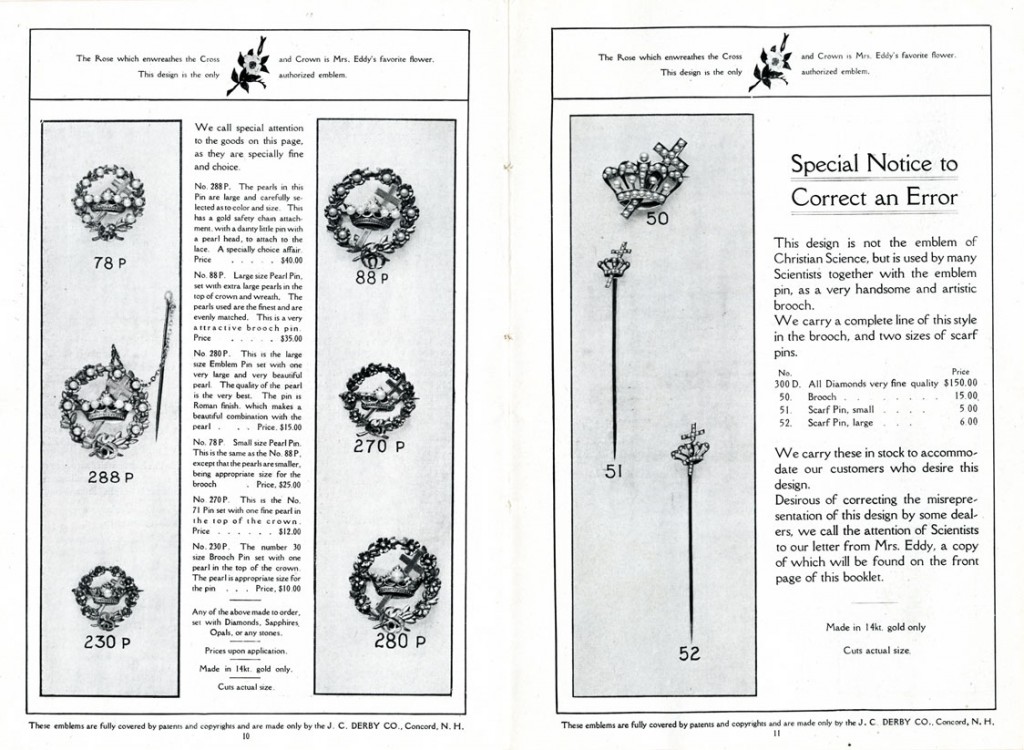In 1889 James Clare (J.C.) Derby (1867-1928), a resident of Concord, New Hampshire, repaired watches at 54 N. Main St. The Concord Directory records that he later worked at Holland & Derby at the same address. By 1898 his occupation was that of jeweler.1
Derby worked that same year with Mary Baker Eddy and Henry P. (H.P.) Moore, a local artist and photographer, to produce and issue a portrait of Eddy. Moore and Derby entered into an agreement “to engage in the business of the manufacture and sale of photographic pictures of Mrs. Mary G.B. Eddy [sic] of said Concord and other pictures of subjects relating to Christian Science interests under the exclusive right to so manufacture and sell given by the said Eddy to said Moore—, said business to be conducted under the style of J.C. Derby & Company.” Derby provided capital for the company and was sole agent for the sale of the portrait and “other photographic subjects connected with Christian Science.”2
The agreement pertained exclusively to pictures. J.C. Derby & Company’s showrooms were located at 30 N. Main St. in Concord and orders could also be placed through the mail. A June 1899 notice in The Christian Science Journal announced the opening of a showroom near The Mother Church in Boston.3
Although Derby was doing business with Moore as J.C. Derby Company prior to May 25, 1899, the company was incorporated on that date according to New Hampshire state records.4 Building on successful sales of the portrait, this filing is most likely directly related to Derby’s idea to create and sell Christian Science emblem jewelry. A letter regarding an unrelated business matter from Eddy’s secretary Calvin A. Frye to Derby, dated June 30, 1899, mentions an “endorsement for that cross & crown jewelry.”5 Derby had put forth his idea and was seeking Eddy’s approval to move forward with its manufacture. He was “obliged to go over to New York on a business trip” and hoped to arrange to have the dies cut while there.6
Having failed to receive the “paper” (the endorsement) he requested, Derby lamented in November that a company in Newark, New Jersey, had begun making and selling cross and crown jewelry to Christian Scientists. He expressed his dissatisfaction with this turn of events because he felt the jewelry sales were his idea. In an effort to get the written endorsement from Eddy most expeditiously, Derby enclosed a letter that had been composed for her to sign, authorizing the manufacture of the jewelry.7
The delay in providing the desired endorsement may relate to the fact that concurrent with Derby’s request, Eddy was busy with other matters occupying her full attention. In July 1899 Josephine Woodbury had sued Eddy for libel over the content of the Communion address of June 4. That suit would not be decided in Eddy’s favor until June of 1901. She was also involved with the paving of her street, Pleasant Street, for which Derby was acting as a liaison with the Concord City Council.8
The endorsement letter was at last sent to Derby on December 7, 1899.9 The next day Derby wrote a letter to Joseph Armstrong, manager of The Christian Science Publishing Society and Publisher of Mary Baker Eddy’s books. He mentioned a conversation the two had had with James A. Neal, a Publishing Society Trustee, a few weeks earlier, where cross and crown pins had been discussed. Derby described the design of the jewelry in some detail:
…a Cross and Crown for the center, surrounded by a wreath of roses and rose leaves. At the bottom of the wreath is the monogram, very nicely wrought out, “C.S.” Mrs. Eddy has selected this as the emblem of C.S. and has given me the work to do.…This is a very lovely piece of work and the jewelry will be made up with pearls, diamonds, opals or any stones that a person may desire, of course, as well as the plain ones….10
Derby had hoped to have the jewelry on the market by Christmas, but found that at this late date it would not be possible to have the dies cut in time. In his letter, Derby also mentioned that the patents were being completed. The patent date marked on Derby jewelry is January 9, 1900.
These pages from an early catalog give a hint of the wide variety of Christian Science emblem jewelry offered by J.C. Derby Company. The right side of the page shows a different style of cross and crown jewelry that Derby sold. It includes a notice to potential buyers that although the jewelry shown on that page has a cross and crown in its design, it is not the emblem of Christian Science. Derby was making it clear that he did not want to mislead potential buyers.
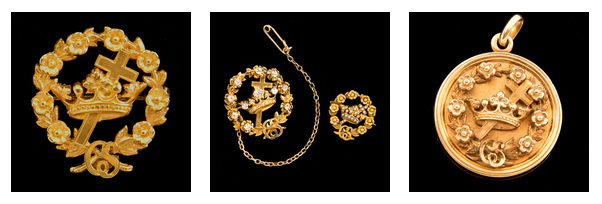
1981.3A (left), 1981.01 (right), 1984.37.123 and 1984.37.109 (center). Just a few of the pieces of cross and crown emblem jewelry in the Library’s collections.
Derby’s cross and crown design is similar to the early Cross and Crown seal featuring the coronet style of crown. This seal appeared first on the cover of the third edition of Science and Health in 1881. When it was later found that this crown was a coronet, or princely crown, bearing no religious significance, the crown on the seal was changed to a celestial crown, or Christian crown, and an announcement about this was published in the June 1908 issue of The Christian Science Journal.11 There is no indication that the style of the Derby-designed Christian Science emblem jewelry ever changed, however.
Biblical references to a crown that is rightly worn only by those who overcome suffering through the messianic cross resonated with Eddy (see, for example, Ezek. 21:26, 27, quoted in part in Science and Health with Key to the Scriptures, p. 223). Elsewhere she wrote, “Love must triumph over hate. Truth and Love must seal the victory over error and death, before the thorns can be laid aside for a crown, the benediction follow, ‘Well done, good and faithful servant,’ and the supremacy of Spirit be demonstrated” 12
According to State of New Hampshire Corporate Division records, J.C. Derby Company went out of business on March 31, 1927.13
One of the lingering questions surrounding this jewelry is—who originally manufactured it? Differences are quite evident in the design of the pins in the collections at The Mary Baker Eddy Library. Many pieces of emblem jewelry bear Derby’s 1900 patent date but no other hallmarks. A few pieces bear both the patent date and the hallmark of Riker Brothers, a Newark jewelry manufacturer in the nineteenth and early twentieth centuries. Could this have been the Newark company Derby referred to in his letter to Frye in November 1899? Of course they would not been have manufacturing jewelry with the 1900 patent date at that time, but perhaps Derby engaged them later as a manufacturer of the emblem jewelry. A significant difference between some of the unmarked pins and the Riker pins is the clasp—some unmarked pins have a simple hook-style clasp, but others have a more sophisticated locking style of clasp. On the other hand, all of the Riker pins examined during this research have the simple hook-style clasp.
More research is needed to find the answers.
- Ancestry,com. New Hampshire, Marriage and Divorce Records, 1659-1947 [on-line]. Provo, UT, USA: Ancestry.com Operations, Inc., 2013. Original data: Marriage Record, 1889; Boston Globe, 13 December 1898, “Charged With Shoplifting: Well-Dressed Man Arrested at Concord, NH” (Derby set a trap to catch a thief).
- SF- Eddy, Mary Baker – Photographs and photographers.
- “Notices,” Christian Science Sentinel, June 1 1899, http://sentinel.christianscience.com/shared/view/265to1m638e?s=t.
- State of New Hampshire, “Corporation Division: Filed Documents: B52686,” accessed August 12, 2014, https://www.sos.nh.gov/corporate/soskb/Corp.asp?1063249.
- Calvin Frye to J.C. Derby, 30 June 1899, L12172.
- Derby to Frye, 4 October 1899, IC 367.
- Derby to Frye, 13 November 1899, IC 367.
- Frye to Derby, 30 June 1899, L12172.
- Mary Baker Eddy to J.C. Derby, 7 December 1899, L10837.
- SF – Armstrong, Joseph Papers – Correspondence 1899.
- “The History of the Cross and Crown Emblem,” The Mary Baker Eddy Library, accessed March 9, 2012, https://www.marybakereddylibrary.org/research/crossandcrown.
- Mary Baker Eddy, Science and Health with Key to the Scriptures (Boston: The Writings of Mary Baker Eddy, 1906), 43-44.
- State of New Hampshire, “Corporation Division: Filed Documents: B52686,” accessed August 12, 2014, https://www.sos.nh.gov/corporate/soskb/Corp.asp?1063249.
